Naming the Mundus maris mascots
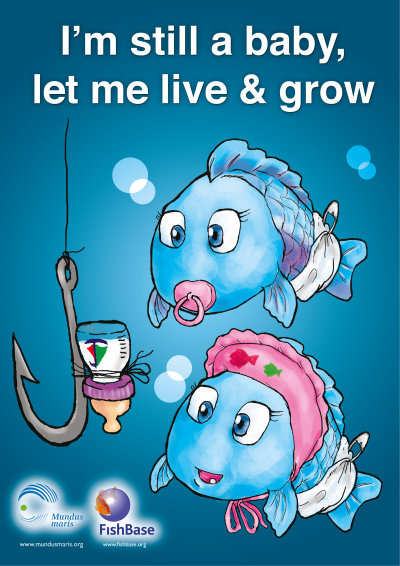 Who had thought about mascots? Nobody, really! But we had received the beautiful rendering of baby fish by Mike Yap, a diver, artist and friend of FishBase in the Philippines, and turned them into the eye-catching poster of this year's Green Week in Brussels. Then there were the equally attractive book marks with the positive message: I'm still a baby, help me live and grow! The feedback from the public showed that some awareness about the need to protect the baby fish was created almost instantaneously. From there it was only one step to want to make the baby fish boy and girl the mascots of Mundus maris, as suggested by one of our youthful supporters, Giulia Bottoni.
Who had thought about mascots? Nobody, really! But we had received the beautiful rendering of baby fish by Mike Yap, a diver, artist and friend of FishBase in the Philippines, and turned them into the eye-catching poster of this year's Green Week in Brussels. Then there were the equally attractive book marks with the positive message: I'm still a baby, help me live and grow! The feedback from the public showed that some awareness about the need to protect the baby fish was created almost instantaneously. From there it was only one step to want to make the baby fish boy and girl the mascots of Mundus maris, as suggested by one of our youthful supporters, Giulia Bottoni.
So, the baby fish needed names to become mascots. Which better way was open than to ask kids and youth for suggestions for names and for stories and adventures they imagined their little heroes had experienced. The participation conditions were straight forward:
1. Propose a she- and a he-name and explain why you propose the(se) specific names and what they mean to you.
2. Imagine what the baby fish go through to avoid being caught before they have grown to adulthood and have had babies themselves. Tell the story!
3. Make suggestions as to what can be done to protect baby fish.
Give the name, place and country of your school or youth group, indicate the age and how many boys and girls make up the class / group. Give the e-mail and a snail-mail address of the coach, team leader or teacher and send your proposals to Questo indirizzo email è protetto dagli spambots. È necessario abilitare JavaScript per vederlo. by 15 November 2012.
By the deadline we have received proposals from 10 groups or schools in five countries involving more than 300 kids and youngsters.
The jury examined them all, including the many pictures showing the youth groups at work as they worked on the problems of overfishing, pollution and other unsustainable practices that threaten the functioning of coastal and marine ecosystems in conjunction with the Mundus maris contest. The jury voted to issue hororary certificates to all young participants, their teachers or coaches and to their schools or other organising institutions. It also pledged books, colour pencils and other tokens for the participatants and/or their schools. It recognises specifically the articulate and creative entry of the Mundus maris Club of the CEM of Cayar, Senegal as the most convincing for naming the Mundus maris mascots and telling their story.
You can see short presentations of all entries on the following pages and will learn, why the mascots are now called Samba (babyfish boy) and Kumba (babyfish girl) following the proposal of the kids in Cayar.
Thanks and congratulations to all participants. And keep an eye on Samba and Kumba - you'll see more of them in a video-animation in the near future. And keep their stories coming - you might be inspiring future animations with the two mascots. You can contact us any time with your suggestions at Questo indirizzo email è protetto dagli spambots. È necessario abilitare JavaScript per vederlo. and we'll be highly appreciative of the continued cooperation.
by Foluke Akinmoladun
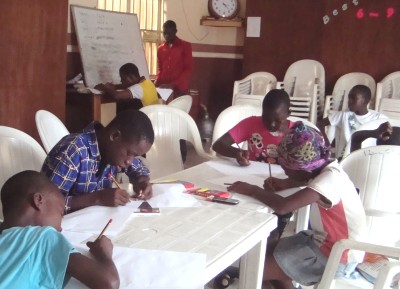 Working with a school teacher and other interested people, including Dr Okonofua U.A., Fine Arts Department at the University of Uyo, Foluke Akinmoladun, Kenny Odili and Tammy Daka successfully organised a get together in November 2012 in Port Harcourt, Nigeria, with children and youth to participate in the names-giving contest for the Mundus maris contest.
Working with a school teacher and other interested people, including Dr Okonofua U.A., Fine Arts Department at the University of Uyo, Foluke Akinmoladun, Kenny Odili and Tammy Daka successfully organised a get together in November 2012 in Port Harcourt, Nigeria, with children and youth to participate in the names-giving contest for the Mundus maris contest.
From the smallest kids in pre-school age to some teenagers, a sense of engagement and expectation reigned among all participants.
What happens to the babyfish? How best to protect them? What could be the names that best characterise courage, wit and love for life? These and other questions were asked and translated into drawings and suggestions to respond to the invitation of Mundus maris.
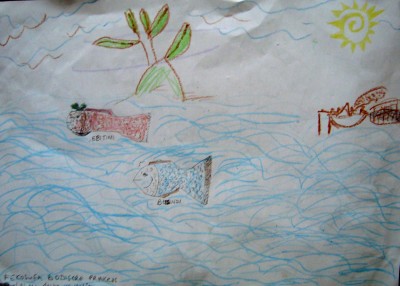
The original approach here in Port Harcourt was to combine the naming with some playful drawing exercises. The crayons do not reproduce very well on the screen, but this did not in any way diminish the fun of the event organised at the Like Minds Christian Church. Fifteen kids and youth participated in that gathering.
By way of example, Fekosufa Bodisere Princess of Niger Delta University suggested Bodisindi for the male and Ebitimi for the female baby fish. Fekosufa gave the reasons for the names as: Bodisindi means a fish that deserves to come and Ebitimi means a good gift. Where I come from, we believe that fish are a good gift to mankind.
Benjamin Pius in junior secondary 3 of High Grade International School off Peace Drive put forward another proposal: Kou for the male and Pieri for the female baby fish. He says: Kou means fish that is good for health, and Pieri means tiny fish.
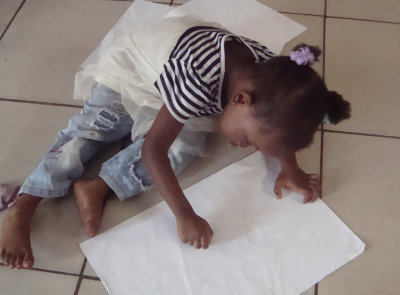 He also suggests the following ways to protect the baby fish: Increase the mesh sizes of the nets so that only big fish can be caught. When these nets are made in the urban areas, they will eventually be available in the rural areas as well.
He also suggests the following ways to protect the baby fish: Increase the mesh sizes of the nets so that only big fish can be caught. When these nets are made in the urban areas, they will eventually be available in the rural areas as well.
There was another event for small kids:
Mrs Effiom and Mrs. Ukot served as coaches for that gathering at Elton Christian School, Abuloma, Port Harcourt, with 8 kids between five and six years old. Never mind the age, they were fully concentrated on the challenge to give names to the baby fish and imagine how best to protect them in healthy environmental conditions.
by Anne Steele Arnett, Headteacher
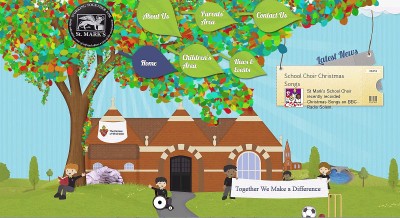 We have been contacted by Nico Caltabiano who is an oceanographer and a Chair of Governors at our school. Two children have written their story. We are a school that wants to build up our maritime education strategy through sustainability and also work towards the children knowing what is around them as we are an Island as a country as well as being a busy container and ocean liner port.
We have been contacted by Nico Caltabiano who is an oceanographer and a Chair of Governors at our school. Two children have written their story. We are a school that wants to build up our maritime education strategy through sustainability and also work towards the children knowing what is around them as we are an Island as a country as well as being a busy container and ocean liner port.
The two children who developed a submission are Lucy Smith aged 11 and Suraj Patel, also aged 11.
We would like to hear about how we can progress our relationship with you to encourage our children to take care of their world and be more knowledgeable about their planet.
Here is the suggestion for names from Lucy and Suraj and where they see the principal dangers for the survival of the babyfish.
I think the fish’s names should be Harry and Hermione, the fictional characters from Harry Potter. Throughout the series of books and movies, they encounter life-threatening dangers, yet each time they survive, just as we want the fish to. In the final book/movie they go on to have children and give more life a chance, just as we want the fish to.
In real life, all fish come across many hazards and predators such as larger fish/sea creatures, fishermen and pollution. To help the fish, we should reduce pollution and littering the oceans. Also tighter controls on fishing and the types allowed to be caught. Captive breeding and reintroduction when the fish are older could help increase the numbers of fish across the world.
- Fishermen: Across the world, trillions of fish are killed for food. In the UK, popular fish like cod are becoming rarer. But the introduction of captive breeding could help to insure that the population of fish is even and sustainable for future generations.
- Pollution: Pollution is another contributing factor to falling number of fish in the world; this can be anything from oil spillages to plastic can rings. Fencing of oil rigs to putting your rubbish in the bin at the beach can all help.
Click here to read the fish version of Harry and Hermione's story.
by Pierre Demol, Curator
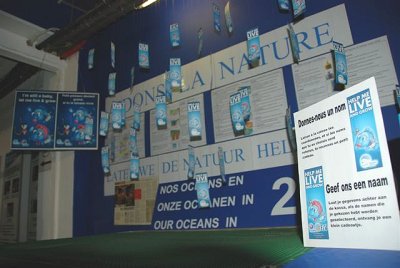 The public Aquarium of Brussels is located near the Basilique Brussels landmark. It works with many schools and youth groups and regularly organises guided tours to introduce the young public to the underwater world, its creatures and the need to protect freshwater and marine environments.
The public Aquarium of Brussels is located near the Basilique Brussels landmark. It works with many schools and youth groups and regularly organises guided tours to introduce the young public to the underwater world, its creatures and the need to protect freshwater and marine environments.
This year's contribution to World Oceans Day, 8 June, and a response to the invitation of Mundus maris to find names for its babyfish mascots was to focus the awareness activities during June and July specifically on to the need to let the babyfish grow to maturity as a key measure to keep and even restore marine ecosystems to a healthy state.
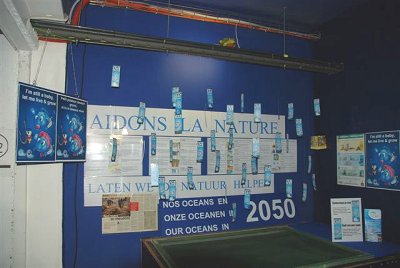 Dozens of kids made suggestions for names for the mascots after being introduced to the challenges of overfishing and nature conservation. It's not as easy though as in a school to keep in touch with the young visitors afterwards to organise further follow-up, but most kids were shocked when they learnt that at current rates of overfishing many of the fisheries feeding us today will be gone in forty years time.
Dozens of kids made suggestions for names for the mascots after being introduced to the challenges of overfishing and nature conservation. It's not as easy though as in a school to keep in touch with the young visitors afterwards to organise further follow-up, but most kids were shocked when they learnt that at current rates of overfishing many of the fisheries feeding us today will be gone in forty years time.
So, we are happy to have participated and seized the opportunity to get basic information to the young visitors and engaged them in thinking about these serious challenges and what to do about them.
by Malang Sanyang, Teacher of Social and Environmental Sciences, GUBS
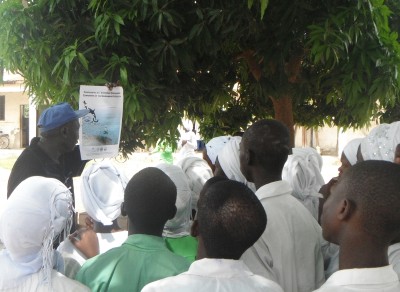
This is the contribution of the Social and Environmental Sciences Study Group at the Gunjur Upper Basic School (GUBS) in The Gambia. Under the leadership of Malang Sanyang and Sulayman Jobe, the school already participated actively in the pilot activities for the FAO - EAF Nansen Project about introducing the ecosystem approach to fisheries into the teaching syllabus in the country.
Protecting baby fish is part of that approach, so our Study Group wanted to be part of the naming contest for the Mundus maris mascots as well. The Headmaster of our school encouraged us to go ahead. Here are the suggestions of two sub-groups:
Sub-Group 1
Name of small fish (male): Binta
Name of big fish (female): Mariama
Reasons why we chose the names:
* Binta is a young fish. She needs the food more because she is young and needs to grow and develop.
* Mariama is said to be the wisest of mothers and knows how to protect her children.
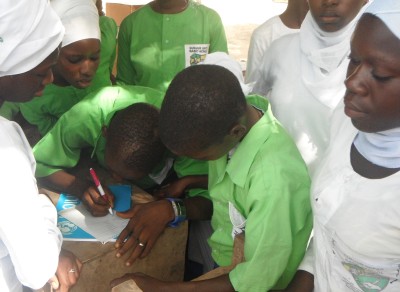
To protect the fish, we should do the following:
* stop coastal erosion.
* stop coastal land clearing.
* say no to the dumping of solid and liquid waste.
* let us prevent the bigger fish from eating up the smaller fish.
Sub-Group 2 - Ecosystem Class
Name of small fish (male): Dawda
Name of big fish (female): Fatou
Reasons why we chose the names:
* Dawda is young, energetic, but with little experience of the world outside her environment.
* Fatou is a young mother, who is so keen to see her child grow into maturity. She is a wise woman who is able to guide and protect her child.
To protect the baby fishes, consider the following :
* Avoid using nets with small mesh-sizes.
* Avoid the basket method of fishing (indiscriminate fishing).
* Stop coastal sand mining.
* The government should employ coast guards to stop illegal fishing and deforestation.
by Alhagie Jammeh, Teacher and coach
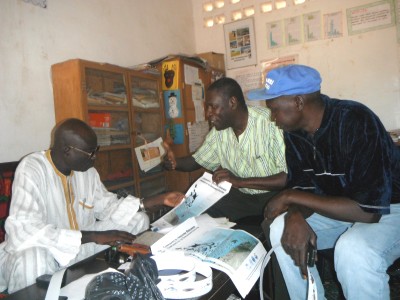
The ecosystem class composed of 24 girls and 21 boys aged between 11 and 14 years participated in the work to propose suitable names for the Mundus marisbaby fish mascots.
Following work in class about the current threats to ecosystems and what to do about them, the pupils came up with the following proposals.
Small fish name: Shaka (male)
Big fish name: Yama (female)
Reasons why we chose the names
* Shaka is intelligent, full of life, very elusive and able to adapt under adverse conditions or situations.
* Yama is young mother who is constantly vigilant and concerned about her child and would do anything to protect her child from danger.
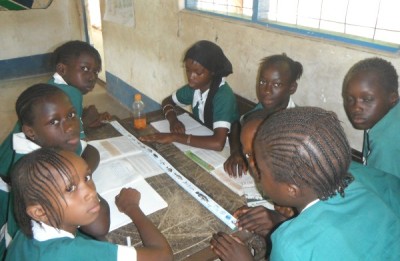
The best way to protect them is to keep them in protected waters until they are mature to be only later exploited by local artisanal fishermen or other commercial fishing.
Contact the teacher and the ecosystem class at the following address
Mr Alhagie Jammeh
Gunjur Lower Basic School
Gunjur
West Coast Region
The Gambia
by Bolong Touray, Headmaster, Serrekunda Lower Basic School
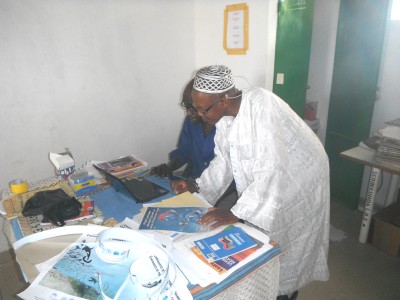
The ecosystem class had 45 pupils, 23 girls and 22 boys, responding to the invitation to propose names for the Mundus marismascots. They were in the age group between 11 and 13 years. Here are the pupils' proposals:
Name of small fish (male): Tembi
Name of big fish (female): Muna
Reasons why we chose the names:
Tembi is a young African child who is strong, active, vibrant and adventurous in nature, with very little experience of the selfish, wicked wider world.
Muna is the name of a legendary African woman, who is loving, productive and keen to protect and take care of her offspring.
The best way to protect and preserve the fish species is to establish protected waters, where they can live and grow until they are mature and big enough to be exposed to legal fishing grounds.
by Doudou Ndiaye, Deputy Director
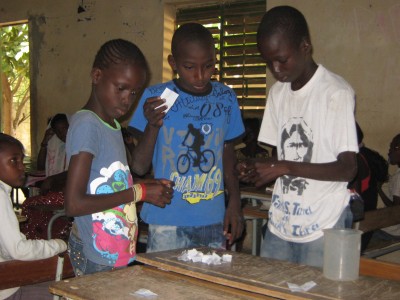 Going through extensive discussions about the need to protect baby fish and the pros and cons of a large number of possible names, the Cm1b class of the Santa Yalla School in Rufisque is proposing the following names:
Going through extensive discussions about the need to protect baby fish and the pros and cons of a large number of possible names, the Cm1b class of the Santa Yalla School in Rufisque is proposing the following names:
For the male baby fish: Toby
For the female baby fish: Bianca
The choice is motivated by the fact that, according to the pupils, the names are easy to pronounce and remember. They also say that they are pretty names.
Leeboon ...
"There was once a little fish called Bianca. One day she was hungry and looking for food. She saw a piece of flesh clinging to a piece of iron. She came over and began to eat. On her return, she nipped under the net of Baay Laay and also escapted the traps. So she learned to survive in the sea."
To protect the small fish consider the following:
* Talk to the fishermen;
* Monitor the fishermen;
* Punish the fishermen, when required.
by Magueth Diop, Headmaster
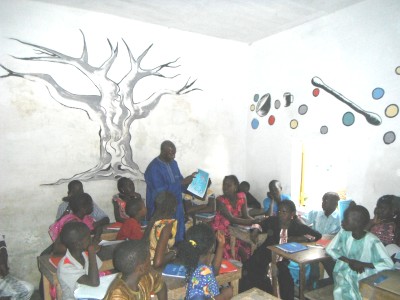 This is to report the results of the work carried out by the pupils of the Elementary School Keur Khadim in Hann Feraille by reflecting on suitable names for the baby fish mascots and their story. We selected 43 pupils, who we have then divided into four groups of about ten kids each. They worked separately and here are the results:
This is to report the results of the work carried out by the pupils of the Elementary School Keur Khadim in Hann Feraille by reflecting on suitable names for the baby fish mascots and their story. We selected 43 pupils, who we have then divided into four groups of about ten kids each. They worked separately and here are the results:
Group A, class CM1
Doundou is the name we gave to him: It means "to live" in Wolof. We gave him this name because we have let him live until he becomes an adult.
Walou is the name we gave to her: This means "to help" in Wolof. We have given her this name because the smaller fish need our help in order to grow at home in the sea.
Doundou and Walou are brother and sister who live together in the sea. They are afraid that people will take them before they become big fish. They just ask to be left a little more time before leaving home and bring them into the pot.
In our group there were five boys and five girls.
Group B, class CM2
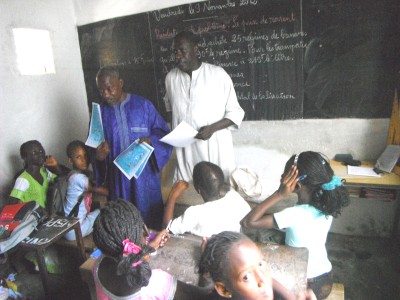
The top fish is called Aarma. This is derived from "protect me" in Wolof. It is called like that because it must be protected against people who harvest and waste them.
The fish below is called Mayla. Its name means it is a gift. We have given this name because the fish are a gift. We must not squander the gifts.
Both fish are friends. Aarma and Mayla want to tell us a message. Let us grow at home in a safe environment instead of killing us while we are still babies. We are not afraid of pots, but we want to become adults first. Let us live.
There were six girls and five boys in our group.
Group C, class CM1
The fish on top is called Yaakar. His name means "hope" in Wolof. It is our hope to have a good fresh fish in the coming years.
The fish below is called Aarko. Her name means "protect them" in Wolof. We must protect them because they are the prey of greedy people, who want to fill their pockets. We must not let them do that.
Babies are innocent fish living in the sea. Every moment they are in danger of being removed from their homes. If we do not protect the baby fish by punishing people who harvest them, our hope to have fresh fish will disappear along with them.
Our group was composed of five boys and six girls.
Group D, Class CM1
The girl is called Yaakar. If we kill the babies there will be no more fish. Her name means "hope" in Wolof.
The boy's name is Touti because he is very small and this is what his name means in Wolof.
The two form a group that wants to make people understand that it is not responsible to catch baby fish. We should let them live if we want to avoid the lack of fish in the future and should establish long biological rest periods.
We had three boys and eight girls in our group.
Mr. Ndiaye, Teacher at the Kayar 1 Primary School
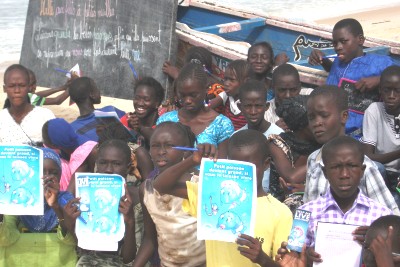 Kayar 1 is a primary school in the traditional fishing village of Kayar, some 60 km north of Dakar, the capital of Senegal. The school has participated in the FAO - EAF Nansen pilot activities testing a teaching kit to support the introduction of the ecosystem approach to fisheries into the curriculum.
Kayar 1 is a primary school in the traditional fishing village of Kayar, some 60 km north of Dakar, the capital of Senegal. The school has participated in the FAO - EAF Nansen pilot activities testing a teaching kit to support the introduction of the ecosystem approach to fisheries into the curriculum.
The 18 boys between 12 and 13 years old and 30 girls between 12 and 14 years old engaging in the names-giving contest for the Mundus maris mascots came forward with the following story.
"Baby Samba and Baby Coumba were small fish that lived near the ocean floor. One day, they heard a noise on the surface. They went to see what was happening and before they knew what was going on, Baby Coumba was captured.
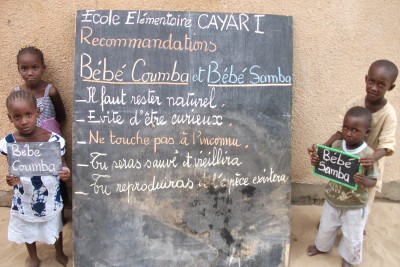 Baby Samba was alone and crying. He then sent a message to the pupils in Kayar to tell them that Baby Coumba was not mature, and that she should be left to grow and reproduce at least once. The pupils intervened with the fishermen who returned Baby Coumba to the sea. She also had a picture message for the kids:
Baby Samba was alone and crying. He then sent a message to the pupils in Kayar to tell them that Baby Coumba was not mature, and that she should be left to grow and reproduce at least once. The pupils intervened with the fishermen who returned Baby Coumba to the sea. She also had a picture message for the kids:
We must be natural again, because the sea is polluted,
Don't be too curious and imprudent as many predator are lurking."
Traditionally, Coumba and Samba are names given to the spirits of the sea in Senegal.
by Abibou Diop, Principal of the CEM in Kayar
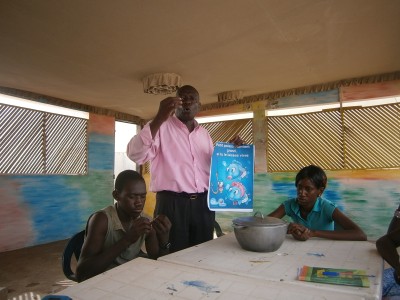
The Mid-level School (Collège d'enseignement moyen, CEM) in Kayar is a public educational institution created in 2006. Located in the municipality of Kayar, an important town mostly inhabited by fishermen and vegetable growers. The school conducts teaching activities of artistic expression and awareness focused on the protection marine ecosystems for the promotion of sustainable and responsible fisheries, since its inception and lately through meeting with Mr Aliou SALL, a social anthropologist who has a solid experience in supporting and the empowerment of traditional fishermen of the West African sub-region. The pupils are in the age group of 11-18 years. We animate intense educational youth work around these issues and also engage internationally, including through our participation in the exhibition at the European School in Brussels and another one in conjunction with the MARE Conference of the People of the Sea, Amsterdam, in 2009. Click here for our profile.
The same enthusiasm and the same dynamics are maintained by the school in our active participation in pilot activities of Mundus maris in collaboration with FAO - EAF Nansen Project to test and introduce the ecosystem approach to fisheries into the curriculum.
The Mundus maris Club of the CEM has twelve (12) girls aged between 13 and 16 years and 16 boys aged 11 to 18 years. Supervision is provided by a teacher in Life and Earth Sciences. This group has the full support of the Principal of the School, as well as the collaboration of the Department of Fisheries and the Marine Protected Area Kayar (MPA), among others. The club has even a few former pupils as members who now study at the Lycée.
In response to the appeal to find names for the Mundus maris mascots, the Club did a lot of work about the subject of overfishing in order to make suggestions for the names, answer questions and concerns about what that means for the future of the industry. The Club has accounted for the local culture and tradition and involved the administrative and technical fisheries and oceanography services, the managers of the Marine Protected Area and some sages of the fishing community.
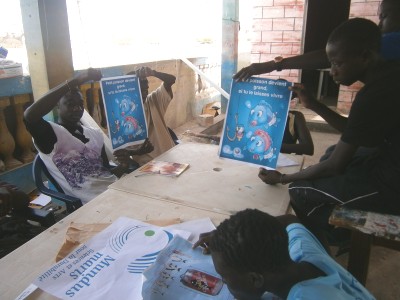
As a result of this analysis, the Club members could better understand the local situation, which species to choose, to raise awareness on the socio-economic impact of overfishing in the area and propose concrete measures to deal with the dangers arising from overfishing and ecosystem degradation.
We therefore chose to represent the mascots as Sardinellas, a pelagic species of economic and sociological importance. It is still abundant and popular also among the socially disadvantaged. It fits very well the Senegalese taste for food and cooking, especially the national dish with rice and fish.
We propose the following names: SAMBA for the male and KUMBA for the female.
Sardinella SAMBA is the name typically given in Senegalese tradition to the second child of a household. The name is assimilated to that of the Prophet of Islam, a great traveler and migrant to spread the word, and to that of the West African trader, peddler or carrier of goods - so the image of sardinella as a migratory species par excellence is most fitting. In a different vein, Samba also evokes the world famous dance from Brazil or Latin America.
Sardinella KUMBA is the name that the Club chose for the mascot girl. In Senegal a natural girl in all states (from virtues and blunders) is called Kumba. Fairly close yet distinct from Samba, she embodies his natural partner. Phonetically the name recalls the dance Rumba, another variant of restless, syncopated dance to the image of the sardinella and the contortions of multiple movements.
In Senegal, Samba and Kumba are the natural couple, partners in various adventures. They embody and symbolize the common man, the ordinary, just as sardinellas transcends social cleavage and barriers.
In our tales and legends, Samba and Kumba are homeless, migrants like the prophet who guarantees the profusion and abundance, but Kumba also evokes the image of a pregnant woman, heavy and dragging. Can we not already see the hunt for the species, which decimated the stock through overfishing?
Economically and sociologically, the two Sardinella species, the round and flat sardinella, cross many sectors. Ecologically they play an important role as food for bigger carnivorous species in the ecosystem and their rapid reproduction make them relatively resilient to heavy fishing. November to June are the best season for fishing Sardinellas in Senegal. During that period, Kayar hosts large numbers of migrant and seasonal workers together with the largest increase in the canoe fleet. The pressure on resources is a significant factor in overfishing, aggravated by use of nets with too small mesh sizes, which catch sardinellas before they have had a chance to reproduce at a size equal or bigger than 12 cm total length.
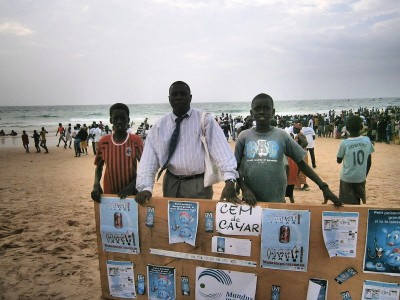
A battery of measures if applied with rigor and firmness can help cope with overfishing and avoid scarcity of Sardinella. In addition to the quota applied by local authorities to licenses all fishing authorizations issued to foreign shipowners should be withdrawn or not renewed. The local fishing industry has sufficient capacity to exploit the resource for the local and the international markets. The local fishing communities in Senegal are taking bold initiatives in the major landing sites: in Kayar, Mbour, Joal and St Louis women fish processors refuse to buy immature fish for processing. They want a minimum length of Sardinellas of 15 or 17 cm as a precautionary measure.
Reduce or control the ease of access to the resource requires a binding action on fishing costs and methods: e.g. by increasing the cost of the license or permit and by ensuring the 28 mm stretched mesh size for nets and 50 mm mesh size for seines.
Protecting the Sardinella from overfishing and ensuring its continued abundance in our waters will have multiple positive effects, foremost by increasing food security, but also safeguarding jobs, particularly female jobs in the processing industry. Reigning in the overfishing would also be positive for economic and financial benfits.
Last but not least, we in the education system are ready to support a much needed change of attitude and a new approach to the perception of the maritime economy that recognises the urgency of restoring coastal zones and oceans to a healthy state. Hence the relevance of Mundus maris efforts for the integration of the ecosystems approach to fisheries and maritime activities into ordinary education.
Click here to read the incredible story of Sardinella Samba and Kumba narrated by the Mundus maris Club of the CEM in Kayar. Watch the video animation of the story by Michael Yap here.









